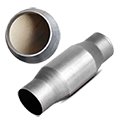1. Petrochemicals
• Hydrogenation reactions: such as hydrodesulfurization (using Ni, Co-Mo, or Ni-Mo catalysts) and hydrocracking.
• Catalytic reforming: Using platinum (Pt) catalysts to increase gasoline octane rating.
• Isomerization reactions: Improving fuel performance, such as using Pt or Pt-Sn catalysts to convert normal alkanes to isoalkanes.
2. Organic synthesis
• Coupling reactions: Pd and Ni catalysts are commonly used in reactions such as the Suzuki, Heck, and Sonogashira reactions.
• Selective oxidation: Such as the oxidation of alcohols to aldehydes/ketones (commonly using Ru, Pt, or Pd).
• Addition reactions: For example, hydrogenation reactions use Ni, Pd, or Pt catalysts (e.g., hydrogenation of olefins to alkanes).
3. Environmental protection
• Automobile exhaust treatment: Three-way catalysts (Pt, Pd, and Rh) are used to convert CO, NOₓ, and hydrocarbons to CO₂, N₂, and H₂O. • Industrial waste gas treatment: For example, in the catalytic combustion of VOCs (volatile organic compounds), precious metal catalysts are often used.
4. Energy conversion and storage
• Fuel cells: For example, in proton exchange membrane fuel cells (PEMFCs), Pt is often used as anode and cathode catalysts.
• Hydrogen production from water electrolysis: Catalysts such as Ni, Pt, and Ir are used to promote hydrogen and oxygen evolution reactions.
• Battery technology: For example, oxygen reduction reaction catalysts (Mn, Fe, Co, Pt, etc.) in metal-air batteries.
5. Ammonia synthesis and other industrial catalytic processes
• Ammonia synthesis: Fe is used as the main catalyst (such as Fe-K-Al₂O₃) to catalyze the nitrogen-hydrogen reaction under high temperature and pressure.
• Methanol synthesis: Copper (Cu)-based catalysts are used to react CO or CO₂ with H₂ to produce methanol.
6. Green chemistry and sustainable development
• Renewable resource conversion: For example, in the conversion of biomass to fuels and chemicals, catalysts such as Ru, Pd, and Ni are used. • CO₂ conversion: such as CO₂ hydrogenation to produce methanol, hydrocarbons, etc. (using metal catalysts such as Cu, Ru, Ni, etc.).




























